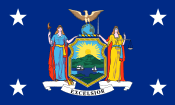Edward Philip Livingston

Edward Philip Livingston (November 24, 1779 Kingston, Jamaica – November 3, 1843 Clermont, Columbia County, New York) was an American politician.
Family background
He was the son of Philip Philip Livingston (1741–1787, son of Philip Livingston) and Sara (Johnson) Livingston (ca. 1749-1802). In 1799, he married Elizabeth Stevens Livingston (1780–1829, daughter of Chancellor Robert R. Livingston). Their daughter Elizabeth Livingston (1813–1896) was the grandmother of Anna Hall Roosevelt, and great-grandmother of Eleanor Roosevelt. After his father-in-law's death, Edward P. Livingston became the master of Clermont Manor which he left to his son Clermont Livingston (1817–1896).
Life
He was a 1796 graduate of Columbia College.
He resided at Clermont Manor from 1802 until the time of his death. He served as a Lieutenant Colonel in the militia, was aide-de-camp to Governor Dewitt Clinton, and served as Judge of the Columbia County Court of Common Pleas.
He was aide to Governor Daniel D. Tompkins, and private secretary to his father-in-law Robert R. Livingston (1746–1813), then US Minister to France.
Edward P. Livingston was a member of the New York State Senate (Middle D.) from 1808 to 1812, and lost his seat to Martin Van Buren. He was a presidential elector in 1820, voting for James Monroe and Daniel D. Tompkins; and again a member of the State Senate (3rd D.) in 1823 and 1824.
Livingston was a member of the Board of Regents of the University of the State of New York from 1827 to 1831.
He was proposed in 1830 for Governor of New York, but his candidacy was questioned by some opponents in the Democratic-Republican Party on the grounds that he had been born on the island of Jamaica. As a naturalized citizen of New York, Livingston was eligible to run, but his foreign birth was used to prevent his nomination. Instead Enos T. Throop, who had succeeded to the governorship when Martin Van Buren became United States Secretary of State, was nominated for a full term as governor, and Livingston was nominated for lieutenant governor. Throop and Livingston won, and Livingston served from 1831 to 1832. He was again a presidential elector in 1832.
He was again a member of the State Senate (3rd D.) in 1838 and 1839. He resigned his seat on October 9, 1839.
Livingston died in Clermont on November 3, 1843. He was buried at Poughkeepsie Rural Cemetery in Poughkeepsie, New York.
Notable relatives
He was a grandnephew of Governor of New Jersey William Livingston; grandson of the signer of the Declaration of Independence Philip Livingston; first cousin once removed of Speaker of the New York State Assembly Walter Livingston; first cousin once removed and nephew by marriage of Secretary of State Edward Livingston; and second cousin of United States Representative from New York Henry Walter Livingston.
Livingston was the great-great-grandfather of First Lady Eleanor Roosevelt.
Sources
- The history of Clermont Manor
- Letter by E. P. L. to David Hosack
- Short Bio
- History of Columbia County, New York by Captain Franklin Ellis (Everts & Ensign, Philadelphia PA, 1878)
- A Genealogy of the Wives of the American Presidents and Their First Two Generations of Descent by Craig Hart (McFarland, 2004, ISBN 0-7864-1956-3, ISBN 978-0-7864-1956-2 ; page 198)
| New York State Senate | ||
|---|---|---|
| Preceded by new district |
New York State Senate Third District (Class 1) 1823 |
Succeeded by Jacob Haight |
| Preceded by vacant |
New York State Senate Third District (Class 2) 1824 |
Succeeded by Richard McMichael |
| Political offices | ||
| Preceded by William M. Oliver Acting |
Lieutenant Governor of New York 1831–1832 |
Succeeded by John Tracy |
| New York State Senate | ||
| Preceded by Alonzo C. Paige |
New York State Senate Third District (Class 3) 1838–1839 |
Succeeded by Friend Humphrey |
